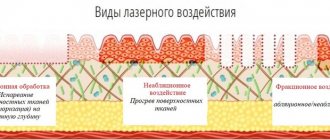Make an appointment with a cosmetologist +7 (3852) 557-557
Leave your phone number and we will call you back
Every person has “moles”: large and small, flat and raised, from flesh-colored to dark brown. In fact, a mole is a pigmented nevus, which can be congenital or acquired. However, new growths on the skin are not only cute moles-spots, but also the so-called. birthmarks, various warts, condylomas, “growths” and “plaques” caused by the human papillomavirus, metabolic disorders or reduced immunity.
When people come to see a cosmetologist, dermatologist or surgeon in order to remove a certain tumor, they are usually driven by only two motives:
- desire to get rid of an “aesthetic defect”,
- the desire to prevent the degeneration of a benign skin formation into melanoma or cancer.
Among the modern methods of “mole removal”, the safest, fastest and most effective is laser coagulation of the neoplasm.
| Before | After |
Removal of warts, thorns, papillomas, birthmarks with laser
Electrocoagulation is quite rough and leaves noticeable marks. Nitrogen cauterization acts superficially; large lesions may require several sessions. Chemicals can cause serious burns and scarring, especially if used carelessly. And celandine... You can smear it with its juice for weeks - and no result.
When removing a tumor with a laser, the surgeon manipulates a thin light guide and acts very precisely. Laser radiation ensures rapid healing of the wound, and the scar is barely noticeable.
How is the procedure performed?
- At the beginning of the session, an injection of an anesthetic drug under the formation.
- Then the doctor acts with a laser beam on the pathological tissue , evaporating it and coagulating the feeding vessel of the spine to stop its further possible growth into the surrounding tissue.
- At the end of the procedure, the doctor injects an antiviral drug under the spine .
- After this, the wound surface is treated with an alcohol solution and a solution of potassium permanganate.
The duration of the procedure depends on the number, location, diameter, and age of formation of formations. The minimum duration of the procedure is 5-7 minutes.
Why do warts, moles, papillomas appear?
Typically, skin lesions are viral in nature. They are caused by the human papillomavirus; more than 100 varieties have already been identified. Some people are more susceptible to this virus, some less so. Hormonal fluctuations in the body greatly influence its activation. Thus, birthmarks and warts often appear and grow in women during pregnancy and after childbirth, and in men after stopping intense sports. Both formations become larger with age.
So, if there are a lot of warts and papillomas, the doctor not only removes them, but also prescribes comprehensive antiviral treatment.
Causes of spines
The cause of spines is a certain non-oncogenic strain of human papillomavirus.
The main factors that provoke the appearance of warts (spikes) are:
- microtraumas on the skin;
- hyperhidrosis of the palms and soles (increased sweating);
- decreased immunity;
- pathology of small vessels;
- STI;
- HIV.
Distinctive features of the spines are:
- their ability to grow deep into the skin;
- formation of new daughter spines;
- resistance to most treatment methods.
It must be remembered that, like all warts, spines are neoplasms that require mandatory consultation with a dermatocosmetologist or oncologist before removal.
What precautions does the wound require after laser removal of a wart?
To prevent a scar or a scar after removing a wart with a laser, you should follow the recommendations listed below:
- Do not cover the wound with a band-aid to prevent inflammation due to the penetration of bacteria. The wound will heal faster if there is constant access to air. Over time, the crust will fall off, and in its place a new layer of epithelium will form.
- After removing the wart, treat the wound with brilliant green, healing ointments, potassium permanganate solution and other local disinfectants for three days. Chemicals and alcohol solutions are strictly prohibited.
- Even if you accidentally scratched the wart removal site and the scab began to separate prematurely, do not completely rip it off. Take the furatsilin solution, soak the separated area with it and carefully cut it off.
- The crust that has formed on the wound cannot be removed; it will fall off on its own.
- Avoid exposing the wound to sunlight; use sunscreen before going outside.
- If a wart has been removed in the intimate area, you can have sex only after the wound has completely healed. As a rule, this is one month.
- It is better not to use cosmetics until the color of the skin on the wound evens out with the surrounding tissues.
- If a month has passed since the wart was removed with a laser, and the wound has not healed, go to the doctor.
- After the procedure, it is recommended to take a course of vitamins E, A, C to make the skin more elastic, strengthen the immune system and restore the regenerative properties of the skin.
Read material on the topic: Dermatological facial cleansing: types, reviews and prices
What to choose: laser or nitrogen removal of warts
The most popular methods for removing warts and other unwanted growths are laser and cryodestruction. If a person decides to remove the tumor, he needs to choose a method.
If the wart is in a visible place, such as on the face, then it is better to choose laser because it does not leave scars.
Nitrogen does not penetrate into the deep layers of the skin, so if you choose cryodestruction, there is a high probability that several procedures will be needed, especially if the tumor is large. Cryodestruction is cheaper than laser, but causes pain.
If you decide to undergo the procedure, consult a dermatologist about which method of wart removal to choose. Laser is more effective, but also more expensive. Cryodestruction is more affordable, but most likely it will take several sessions to completely get rid of the wart.
About direct indications and contraindications for laser tumor removal
Necessarily remove tumors:
- those under year-round exposure to solar radiation (UV rays increase the risk of tumor degeneration);
- subject to constant trauma on the scalp, neck, palms, feet, waist, armpits and groin area;
- with a hereditary predisposition to skin cancer;
- in case of a large accumulation of tumors in any part of the body.
New growths cannot be removed with a laser if:
- there is a suspicion of the development of a malignant process;
- there are inflammatory diseases in the body or in the area affected by the laser beam;
- acute infectious diseases and exacerbation of chronic somatic diseases;
- herpes in the acute phase;
- keloid disease.
In addition, it is not recommended to remove tumors with a laser in women during menstruation.
Indications
When the following symptoms appear, plantar warts must be removed:
- The tumor causes pain and discomfort.
- The growth is large or continues to grow.
- Periodically the spine bleeds.
- Multiple formations were noticed in the foot area.
It is important to understand that in addition to aesthetic problems, plantar warts most often pose a threat to health, so you should not neglect their treatment.
The first two weeks after removal
The first 2-3 days after removal, slight pain, redness around the removed formation, swelling, and itching may be observed, which go away on their own.
5-7 days after the procedure, a crust forms, which is rejected on its own after 7-10 days. A pink spot remains at the site of removal, which after 1-2 months fades and becomes invisible.
IMPORTANT! Within 2 weeks, the patient is required to treat the wound surface according to the instructions given by the doctor immediately after the procedure.
After these 2 weeks, the doctor conducts a preventive examination and, if necessary, gives further recommendations.
During the laser tumor removal procedure
The doctor begins to remove the tumor only after dermatoscopy - an examination using a special optical device that greatly magnifies the tumor and makes it possible to make a preliminary diagnosis as accurately as possible. As a rule, tumors are removed with a laser in one stage, after a preliminary consultation with an oncologist surgeon. If there is a large accumulation of “extra” moles, warts and fibroids, the doctor may suggest removing them in stages, for example, in 2 sessions. However, the good thing about the method of laser coagulation of neoplasms is that the removal of any “skin defect” takes place in a few seconds (maximum 1 minute), preparation for the procedure (anesthesia) takes much longer.
The laser can operate in several modes: excision, coagulation, tissue evaporation. Often, the doctor chooses the first mode and, using a laser, which replaces a scalpel, “cuts out” the tumor. Moreover, during the removal of the tumor, the laser simultaneously coagulates (“cauterizes”) the blood vessels, so the method is bloodless!
After the procedure, the patient can immediately return to his normal lifestyle, but the removed tumor is sent for histological examination, which should confirm the absence of a malignant tumor.
What are the advantages of laser tumor removal?
Doesn't hurt:
An absolutely painless procedure, because... performed under local anesthesia.
Predictable:
The doctor fully controls the depth of exposure (the laser beam does not injure surrounding tissue, which means the risk of scarring or depigmentation is minimal)!
Safely:
Laser removal of tumors is a non-contact, bloodless, sterile method, therefore the risk of an inflammatory process is eliminated!
Fast:
The procedure takes a few minutes or even seconds, and after laser removal of the tumor, the patient can return to everyday activities the same day!
Effective:
Moles, warts and other neoplasms are completely removed in one procedure and, as a rule, they will never appear on a given area of skin again!
How does laser removal of warts occur?
The most common skin disease is acne, followed by warts. Statistics say that 10% of people have the papilloma virus. The papillomavirus causes abnormal skin tissue, causing people to suffer from various diseases, ranging from warts to serious problems such as cervical cancer.
Warts come in different sizes: from 1 mm to 3 cm. They form on the mucous membranes, skin, and can be convex or flat. Once the virus has entered the human body, it cannot be removed and will remain for life. As soon as a person's immune system fails, a wart will appear.
Healthy people can easily become infected from carriers of the infection through shared objects, household appliances, or sexual contact. There is a high risk of infection on the beach, in the pool, sauna, bathhouse and other places where large numbers of people relax. The papillomavirus dies when exposed to sunlight, so the risk of infection in the evening and at night is significantly higher.
Recommended articles on the topic:
- Painless lip modeling: techniques and recommendations
- Beauty injections: types, preparations, reviews
- Eyelash restoration at home and in a beauty salon
A person may not realize that he has become infected, even for several months, because signs of the disease appear only after 2-5 months. Not only a decrease in immunity provokes the appearance of warts, but also the following factors:
- Tight and uncomfortable, synthetic shoes.
- Sweaty feet.
- Metabolic disease.
- Endocrine pathology.
- Acrocyanosis of the limbs.
- Sudden hypothermia.
- Stress.
- Fungal and other infectious diseases.
- Insufficient hygiene.
- Lack of nutrients in the body.
- Casual sex.
- Failure to comply with the rules of asepsis and antiseptics during manicure and pedicure.
Laser removal of warts is carried out only after consultation with a dermatologist or cosmetologist. Wart cells are 75% water. Laser installations evaporate this liquid, due to which the neoplasm is removed. The removed material is subsequently subjected to histological analysis. During the procedure, one of various laser systems is used:
- CO2 laser - pathological tissues are destroyed, the liquid is evaporated using a laser beam. A CO2 laser emits infrared radiation with a wavelength of 10,600 mn. The disadvantage of this method is that after the procedure scars may remain on the patient's skin.
- The erbium laser is very similar to the CO2 laser, only it has a shorter wavelength - 2940 mn, and is twelve times more effective. Another advantage of this laser is that it is less traumatic to tissue.
- A pulsed dye laser leaves virtually no scars and does not cause discomfort to the patient during the procedure. Unlike CO2 laser and erbium laser, it has a selective effect on oxyhemoglobin, leading to the destruction of wart capillaries.
Read material on the topic: Removing moles on the face without pain and consequences
Symptoms of plantar warts
- At the first stage, a shiny plaque appears on the foot, later the skin in this place becomes keratinized and becomes rough and hard to the touch.
- A growth appears on the foot with a diameter of up to 2 cm and a height of up to 3 mm. The shape of the formation is round or oval.
- Often a large spine appears first, around which multiple small ones subsequently form.
- The growth has a light brown or yellowish-white tint, and in some cases black dots appear on the keratinized surface.
Laser removal of thorns
Laser hair removal has proven its effectiveness for many years. The laser systems used in our salon in Yekaterinburg produce a powerful stream of radiation, which sharply increases the temperature in the affected tissues and, as it were, “evaporates” them, thus removing the thorn.
The laser beam acts specifically without affecting surrounding healthy tissue. It simultaneously cauterizes the blood vessels, eliminating the risk of bleeding and infection of the wound.
Effective care treatments
Cryotherapy
Wart removal
Plantar warts, or thorns, are a very common problem among patients of any age and gender. Such growths are localized on the supporting areas of the foot or toes. Most often, neoplasms cause significant discomfort when walking, so it is recommended to remove them immediately after detection.
Modern dermatology and cosmetology offers many ways to combat plantar warts, but one of the safest and most reliable is laser removal. It is this technique that allows you to get rid of growths without blood and long-term rehabilitation, as well as avoid the appearance of scars. The procedure is performed on an outpatient basis, does not require lengthy preparation and can be performed immediately after examination by a doctor. For this reason, the method is used to treat many types of plantar warts.
About the results of laser tumor removal
Modern laser treatment of moles, warts, birthmarks and other neoplasms has already proven to be highly effective and safe. Therefore, you can safely contact specialized clinics equipped with high-quality and powerful laser equipment for removing tumors!
In the absence of direct indications, the decision to remove the annoying mole or leave it is always made by the patient. However, remember that removing any tumor is a kind of preventive strike that leaves no chance for the development of malignant processes on the skin!










